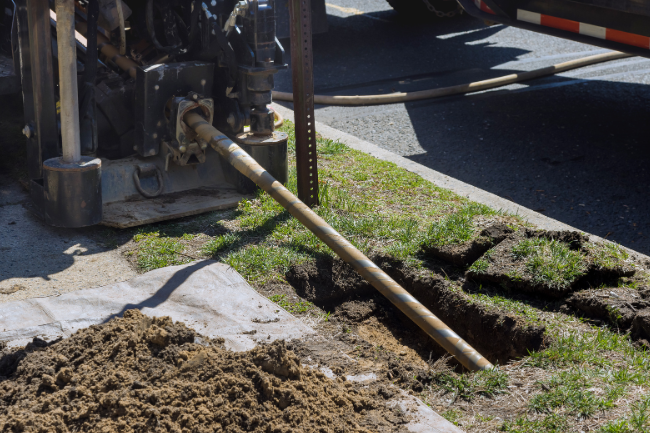The Ultimate Guide to Trenchless Sewer Repair
Posted by William Heinselman on
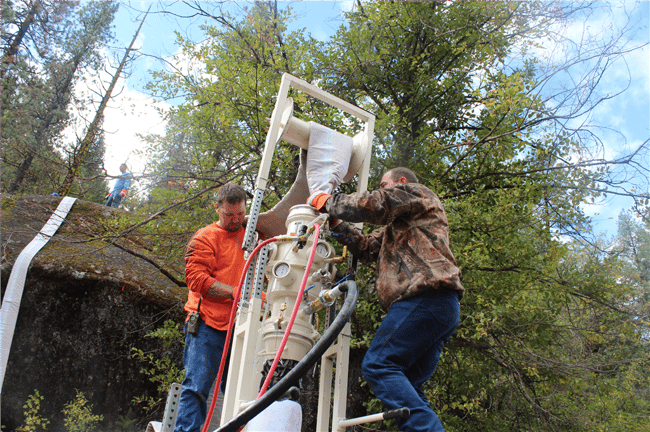
Safeguarding public health and preserving the environment hinge on the efficient functioning of sewer systems. As urban infrastructure ages, the pressing need for effective repair solutions has given rise to a transformative technology: trenchless sewer repair.
This guide explores the pivotal role of sewer repair, the challenges posed by traditional methods, and how trenchless technology is reshaping the landscape, offering a more efficient, cost-effective, and environmentally friendly approach to maintaining our critical infrastructure.
Introduction to Trenchless Sewer Repair
In the ever-evolving landscape of plumbing and infrastructure maintenance, trenchless sewer repair has emerged as a transformative solution, revolutionizing the way we address underground pipeline issues. Unlike traditional methods that involve extensive excavation and disruption, trenchless technology offers a more streamlined, efficient, and environmentally friendly approach to repairing and rehabilitating sewer lines.
What Is Trenchless Technology?
Plumbers have increasingly incorporated trenchless technology into their services, providing various methods for sewer line replacement. A professional can assess and determine the most suitable technique for your specific situation.
One of the advantages of trenchless technology is its ability to repair or replace faulty sewer lines with minimal disruption, requiring only one or two holes on your property. Plumbers employ specialized equipment to execute these tasks, avoiding the mess associated with conventional methods.
Here's a breakdown of two trenchless techniques:
- CIPP (Cured In Place Pipe): In this trenchless method, a special liner filled with resin is pulled or blown into the pipe. Once in position, the resin hardens, creating a seamless and smooth pipe that facilitates free flow. The life cycle of CIPP is an impressive 50 years, providing a long-lasting solution to sewer line issues.
- Pipe Bursting: Pipe bursting, another trenchless approach, necessitates two holes and can be applied for repairing or replacing short or long sections of sewer pipe. A cable, attached to a bursting head, is inserted into the pipe and pulled through the existing sewer line. This process simultaneously pushes away the old pipe and inserts a new one, minimizing the need for extensive excavation.
While both methods are effective, the primary distinction lies in the impact on the pipe diameter. CIPP reduces the diameter but compensates with a seamless interior, ensuring smoother flow. On the other hand, pipe bursting allows for an easy increase in pipe diameter, offering enhanced flow capacity. This feature is particularly beneficial for businesses, municipalities, and larger homes in Sacramento.
Choosing the right trenchless technology depends on the specific requirements of the sewer system, ensuring a tailored and efficient solution with minimal disruption.
The History of Trenchless Technology
Trenchless technology achieved groundbreaking advancements by, quite literally, avoiding the need to break ground. Previously, the repair, replacement, or rehabilitation of underground infrastructure, like sewer piping, necessitated extensive excavation, disrupting yards, streets, and structures above it.
In contrast, trenchless technology minimizes or eliminates the need for trenches, resulting in significant time and cost savings. Additionally, it presents an environmentally friendly alternative, causing substantially less disruption to businesses, homeowners, traffic, and various activities.
Advantages of Trenchless Technology
Trenchless pipe repair offers several benefits compared to traditional methods that involve extensive excavation. Here are some key advantages:
- Minimal Disruption: Trenchless methods require only small access points, reducing the need for large-scale excavation. This results in minimal disruption to the surrounding environment, including roads, sidewalks, landscaping, and structures.
- Cost Savings: While the initial costs of trenchless technology may be higher, the overall expense is often lower when considering reduced labor, restoration, and traffic control expenses associated with traditional excavation methods.
- Quick Repair Times: Trenchless methods are typically faster, allowing for quicker repairs and less downtime for communities. This is especially crucial in densely populated areas where minimizing disruption is a top priority.
- Preservation of Infrastructure: Trenchless technology helps preserve existing infrastructure by minimizing the need for extensive digging and excavation. This is essential for maintaining the integrity of urban landscapes.
- Environmental Impact: The reduced excavation and restoration associated with trenchless methods lead to a smaller environmental footprint. This aligns with the growing emphasis on sustainable and eco-friendly construction practices.
- Versatility: Trenchless technology is versatile and can be applied to a variety of situations, including repairing or replacing sewer lines, water pipes, and gas lines. It is suitable for both residential and commercial applications.
- Long-Term Durability: Trenchless pipe repair methods often result in durable solutions. For example, CIPP (cured-in-place pipe) can extend the life of pipes for several decades, reducing the need for frequent repairs.
- Improved Flow Capacity: Some trenchless methods, such as pipe bursting, allow for the replacement of pipes with larger diameters. This can enhance the flow capacity of the pipes, addressing issues related to restricted flow.
- Less Landscape Disturbance: Trenchless methods leave landscapes largely undisturbed compared to traditional excavation. This is particularly beneficial for homeowners and businesses concerned about the impact on their property aesthetics.
In summary, trenchless pipe repair methods provide a more efficient, cost-effective, and environmentally friendly alternative to traditional excavation. These benefits make trenchless technology an increasingly popular choice for addressing underground infrastructure issues in various settings.
Cost Benefits of Trenchless Technology
There are three significant cost advantages associated with opting for trenchless technologies to mend your damaged pipe, as outlined below.
- Minimal Labor: Traditional pipe repair entails more manual labor and added costs for excavation and landscaping. Trenchless technology eliminates the need for digging, resulting in less labor even after the pipes are fixed, provided there is access to the entry points.
- Resource Efficient: Choosing trenchless technology for pipe repair or replacement offers financial, environmental, and time efficiency. Despite apparent higher costs, when considering time, labor, and aftermath expenses of traditional methods, trenchless technologies prove more cost-effective. They are eco-friendly, avoiding exposure of toxic substances during digging. Unlike traditional replacement, trenchless methods reuse the existing compromised pipe by lining it with new material. Additionally, trenchless technology completes the process within hours, contrasting with the days or weeks required by traditional methods.
- Longevity: Unlike metal or plastic pipes, Perma-liner and epoxy resin solutions in trenchless technology boast a lifespan exceeding 50 years. Serving as more than a temporary fix, these trenchless solutions not only repair but also proactively prevent future line damages.
Environmental Benefits of Trenchless Technology
Trenchless sewer replacement provides a highly effective and durable solution for damaged pipes. While the initial cost may appear comparable to traditional methods, the long-term benefits of trenchless technology result in significant savings and environmental advantages, such as:
- Fewer chances for harmful substances to infiltrate your water supply or elsewhere.
- In the past, metal or PVC sewage pipes were typically discarded, and new pipes of the same material were installed. However, trenchless technologies use an epoxy-resin liner that is a more environmentally friendly approach to pipe repair and replacement.
Potential Downsides of Trenchless Technology
While trenchless technologies offer convenience, some may question if there are significant drawbacks. Well, before making trenchless plumbing your go-to solution, it's essential to be aware of some potential issues.
Here are some of the significant challenges associated with trenchless technology that you might encounter:
- Limited material choices when replacing or relining pipes.
- Trenchless technology may not be suitable for every form of damage.
- The up-front costs are typically more expensive than traditional methods.
- Pipelining could reduce the diameter of the pipe and restrict flow.
How Trenchless Sewer Repair Works
Embarking on the journey of trenchless sewer repair unveils a meticulous step-by-step process designed to restore functionality to residential sewer lines with minimal disruption. Let's delve into the intricacies of this innovative method:- Initial Assessment: The process commences with a comprehensive assessment of the sewer line's condition. Plumbers utilize advanced tools, such as video cameras specifically designed for navigating sewer systems, to inspect and identify any damage. This initial assessment is crucial for understanding the scope and nature of the issue.
- Damage Evaluation: Building on the initial assessment, the plumbers carefully evaluate the extent of the damage within the sewer line. This includes determining whether specific sections require repair or if the entire line needs replacement. For older homes in places like Sacramento, where sewer lines may be composed of aging materials, this evaluation is particularly vital.
- Access Point Identification: Once the damage is assessed, plumbers pinpoint the access point at the shallowest location of the sewer line. This could be an exterior entry point, where the line enters the residence, or in the basement, depending on the specific layout of the plumbing system.
- Debris Removal with Hydro Jetting: To prepare for repair, any existing debris and obstructions within the sewer line are removed using a high-pressure water jetting method known as hydro jetting. This thorough cleaning ensures that the line is clear and ready for the subsequent steps.
- Cured In Place Pipe (CIPP) Liner Installation: The heart of trenchless sewer repair lies in the installation of 'cured in place pipe' (CIPP) liners. These liners, made from a resin that hardens after placement, are carefully inserted into the damaged section. The resin is then infused into the liner using a vacuum method, allowing it to conform to the contours of the existing pipe.
- Curing Process: Following liner installation, the curing process takes place. The resin undergoes a curing period, typically lasting between 1 to 30 hours, depending on the diameter of the pipe. This process solidifies the material, effectively creating a new, durable pipe within the existing infrastructure.
- Final Inspection: After the curing process, a thorough inspection is conducted using the video camera. This final step ensures that the CIPP liner has been properly placed, cured, and adhered to the damaged section. If successful, the sewer line is ready for immediate use.
Common Trenchless Technology Methods
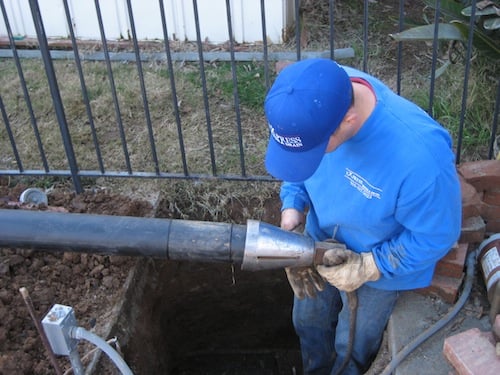
Several methods exist for repairing or replacing sewer lines, and modern technologies have significantly reduced the invasiveness of the process compared to previous years. Utilizing diverse methods and products, plumbers can now repair both sewer lines and water lines with minimal disruption to your lawn, landscaping, walkways, and driveways.
The trenchless technology methods employed for plumbing repair and replacement in Sacramento homes, businesses, and municipalities are as follows:
- Pipe bursting: The pipe bursting method replaces entire sections of a pipe by using a bursting head to break through various pipe materials such as plastic, PVC, clay, Orangeburg, copper, and cast iron. This process requires a point of entry, a receiving pit, and pneumatic or hydraulic equipment. The expander head, specially designed for the task, is inserted into the failing pipe, fragmenting the old pipe and laying a seamless pipe in its wake, resulting in a free-flowing sewer line once connected to the system.
- Pipe lining: Manhole-to-manhole lining offers a trenchless solution for municipal sewer repairs, utilizing epoxy resin solutions similar to standard pipe relining. This method simplifies complex and costly sewer damages in underground city sewer lines.
- Slip lining: Involves inserting a smaller-diameter pipe, often made of high-density polyethylene (HDPE), into an existing damaged or deteriorating pipe. This method provides a cost-effective and minimally disruptive solution, reinforcing the structural integrity of the original pipe and extending its lifespan without the need for extensive excavation.
- Directional drilling: Allows for the installation of underground pipes, conduits, and utilities without the need for extensive excavation. Using specialized equipment, such as a directional drilling rig, the process involves drilling a borehole along a predetermined path.
- Cured-in-place pipe (CIPP): This method involves inserting a flexible liner saturated with resin into the existing damaged pipe, and through the application of heat or ultraviolet light, curing the resin to create a durable, seamless, and structurally sound replacement within the original infrastructure.
- Hydro jetting: Employs high-pressure water jets to clear blockages, debris, and build-up within sewer and drainage pipes. This method effectively removes obstructions, such as tree roots, grease, and sediment, restoring optimal flow without the need for excavation.
- Video sewer inspection: Utilizes specialized cameras to assess the condition of sewer lines without excavation. These cameras are inserted into the pipes, providing real-time visual feedback to plumbers who can identify issues such as cracks, blockages, or structural damage.
Trenchless Technology Equipment
Specific job sites require distinct methods and tools; for instance, the approach and tools used in pipe bursting differ from those in pipe relining. Here's a brief list of equipment along with an overview of their uses.
- Expander Head: Used in pipe bursting, modern expander heads feature a smaller leading end for precise navigation through the existing pipe, addressing past challenges. Pipe bursting is a last-resort method for extensively damaged sewer, gas, or water lines.
- Ditch Witch Directional Drills: This steerable trenchless method, utilizing surface-launched drilling rigs, minimizes environmental impact, making it suitable for various soil conditions and crossings. Express prioritizes eco-friendly drilling practices to reduce our carbon footprint.
- Lateral Lining: Perma-Liner epoxies facilitate the creation of a new, resilient pipe within the failing one, with formulations tailored to soil composition for enhanced longevity.
- Sectional Point Repair Kits: Offering structural repair without excavating or lining the entire pipeline, this system is ideal for pipes with small damage points, ensuring precision in the repair process.
Trenchless Sewer Repair vs. Traditional Plumbing Repair
Trenchless sewer repair employs advanced technologies like Cured-In-Place Pipe (CIPP), pipe bursting, and directional drilling. This method minimizes excavation, necessitating only small access points for repairs, thereby causing minimal disruption to landscapes, driveways, and structures.
The repair process is generally faster, often completed within a day, and although initial costs may be higher, the overall expenses can be lower due to reduced labor and restoration needs. Trenchless repairs offer durable and long-lasting solutions, effectively extending the lifespan of pipes.
In contrast, traditional plumbing repair relies on conventional excavation methods, involving extensive digging that disrupts landscapes, driveways, and structures. This approach can cause significant disruption to the surrounding environment, impacting daily activities. The repair time is often longer, with projects spanning days or weeks.
While initial costs may be lower, expenses can escalate due to extensive labor and restoration needs. Traditional plumbing repairs provide effective solutions but may require more frequent maintenance and repairs over time.
Trenchless Sewer Repair Costs
While the initial expense of trenchless technology may seem higher than traditional methods, the long-term financial benefits often outweigh the immediate investment. Trenchless sewer line replacement significantly reduces the need for extensive excavation, minimizing labor costs associated with digging and subsequent landscaping restoration. The speed of trenchless repairs is another financial advantage, with many projects completed within a day, translating to fewer labor hours and, consequently, lower costs.
In contrast, traditional sewer line replacement involves extensive excavation, leading to higher labor expenses and substantial restoration costs for landscaping and structures. The prolonged duration of traditional methods can result in increased labor hours and potential additional expenses, such as hotel stays for residents during the repair period.
Moreover, trenchless technologies offer enhanced longevity and durability, reducing the frequency of future repairs and maintenance, which can result in substantial long-term savings. While the financial considerations may vary depending on the specific project and circumstances, trenchless sewer line replacement often proves to be a cost-effective and financially prudent choice over the life cycle of the infrastructure.
Trenchless Technology for Residential Properties
For homeowners in Sacramento, where historic charm often comes with aging infrastructure, trenchless technology emerges as a game-changer for sewer repairs. Trenchless methods bring a host of benefits.
Firstly, they minimize the disruption to Sacramento's picturesque landscapes and heritage properties, requiring only small access points for repairs. This means your yards, driveways, and structures stay relatively untouched during the process. Additionally, the speed of trenchless repairs is a real boon. With projects often completed within a day, homeowners can enjoy a swift resolution without prolonged inconveniences.
Now, post-trenchless sewer repair, ensuring your yard stays in top shape becomes crucial. Here are some maintenance tips:
- Give your yard some time to recover after the trenchless hustle. Avoid heavy equipment and vehicles for a bit to let the soil settle.
- Keep an eye on your green companions – trees and shrubs might need some extra care. Water them adequately, and consider adding a layer of mulch to help retain moisture.
- Regularly inspect the repaired area for any signs of settling or uneven ground. If you spot anything unusual, don't hesitate to consult with your trenchless repair experts.
Trenchless Technology for Commercial Properties
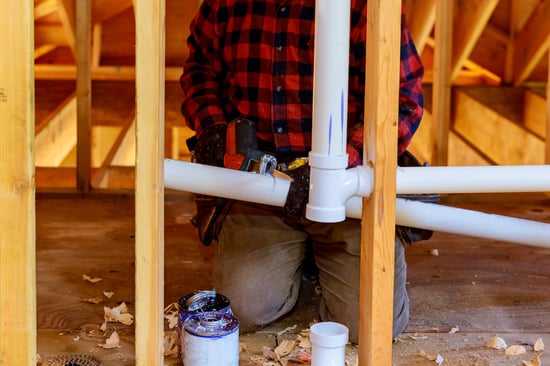
For businesses in Sacramento, where maintaining a professional image is crucial, trenchless technology ensures that exterior landscapes and parking lots remain intact during repairs. This minimizes disruptions to daily operations and avoids the unsightly aftermath of extensive excavation. The speed of trenchless repairs is another asset for commercial properties, allowing businesses to resume normal activities swiftly.
In addition to sewer repairs, directional drilling is employed for installing underground utilities without disrupting existing infrastructure. This is especially beneficial for expanding commercial properties or installing additional services. The precision and versatility of directional drilling make it an ideal choice for navigating complex urban environments.
For property managers and owners in Sacramento, trenchless technology offers a strategic and cost-effective approach to infrastructure maintenance, ensuring that commercial operations can continue seamlessly while enhancing the longevity and efficiency of vital systems. Whether it's addressing sewer issues, expanding utilities, or undertaking other underground projects, trenchless technology is a valuable asset for the dynamic landscape of commercial properties in Sacramento.
Trenchless Technology for Municipal Projects
Trenchless technology emerges as a game-changer for municipal sewer repair projects, offering a host of advantages that revolutionize the rehabilitation process. The most notable benefit lies in its ability to minimize disruption to urban landscapes. Methods like Cured-In-Place Pipe (CIPP) and pipe bursting require minimal excavation, preserving the integrity of roads, sidewalks, and green spaces.
This is particularly critical in densely populated municipal areas where maintaining smooth traffic flow and the aesthetics of public spaces is essential. Furthermore, the upfront investment in trenchless methods, although slightly higher, translates into significant long-term cost savings. Municipalities benefit from reduced labor, equipment, and restoration expenses, optimizing budgets for essential infrastructure projects and enhancing overall fiscal efficiency.
Beyond cost considerations, the swiftness of trenchless repairs is a key advantage. Municipalities can efficiently address sewer issues, completing projects in less time compared to traditional methods. This not only minimizes inconvenience for residents and local businesses but also fosters a quicker return to normalcy. Additionally, trenchless technology contributes to the extended lifespan of municipal sewer systems by providing durable and long-lasting solutions.
The materials used in these methods, such as the liners in CIPP, offer a robust, seamless replacement within existing pipes, reducing the need for frequent maintenance and repairs. Trenchless technology aligns seamlessly with environmentally conscious practices, minimizing excavation and material disposal and supporting municipalities in achieving sustainability goals.
Trenchless Technology Examples
Trenchless repair methods have gained widespread acceptance across various industries due to their efficiency, reduced disruption, and cost-effectiveness. Here are some examples and case studies that showcase the successful application of trenchless technology.
- Yosemite National Park: A deteriorated water main presented a unique challenge. Despite the National Park Service replacing much of the line, a section encased in 4-foot-thick cement with river boulders posed an insurmountable obstacle for traditional methods. Contractors hesitated due to the difficulty and messiness of the job. However, we were up for the challenge, offering a trenchless solution for this complex and unconventional repair.
- Sicily, Italy: Constructed in the 1980s, a water main faced unusual deterioration within two decades due to seismic activity in 2003, leading to frequent service interruptions. GeoRadar detection identified the sections requiring repair, and trenchless technology swiftly addressed the issues. The Nuovo Scillato water main is now fully operational, with the entire rehabilitation project completed in under two months, marking a significant achievement in trenchless technology for Italy.
- Eureka, California: In a California city, the K Street Emergency Sanitary Sewer Main Rehabilitation Project aimed to replace a 107-year-old sewer main. The critical project, near Humboldt Bay, involved replacing 600 feet of sewer main to avoid environmental damage and potential fines. To minimize surface disruptions and the risk of spills, trenchless pipe bursting was chosen. This method involves using a device to fragment the damaged pipe and immediately replace it with new piping, ensuring clean-running lines. The project, completed in just about one month, was executed without any issues.
- Inverness, Scotland: In Inverness, Scotland, a high-traffic city street required sewer rehabilitation. To avoid traffic delays, especially during tourist season, trenchless methods were chosen. The Scottish Water project team closed roads nightly from 7:30 pm to 7:00 am, completing the entire project in just two weeks. This minimized disruption for businesspeople, residents, and tourists, ensuring satisfaction among all stakeholders.
- Halifax, Nova Scotia: In 2017, Halifax Water initiated Underground Overhaul to halt sewage leakage into Halifax Harbor. Upon learning of eligibility for the Clean Water and Wastewater Fund Program, covering 75% of costs, a challenge emerged—the project had to finish by March 2018 to secure funding. With sewers near multimillion-dollar residences, trenchless technology was crucial. Despite hurdles, including bringing in special crews from the U.S., Halifax Water triumphed. The last liner section was installed on December 4, and the system was operational the next day—almost three months ahead of the deadline.
- Cincinnati, Ohio: Facing an aging sewer infrastructure from the late 1800s and early 1900s prone to backups, the Metropolitan Sewer District of Greater Cincinnati addressed the issue. The legacy system discharged over 66 million gallons of polluted water into Duck Creek annually, with projected repair costs near $18 million. Employing trenchless technology, the project team successfully intercepted drainage with a large storm sewer, completing the project under budget (almost $10 million under) and ahead of schedule. This approach spared Duck Creek from another 46 million gallons of sewer overflow.
Trenchless Technology Glossary
In the field of trenchless technology, a specialized vocabulary has evolved to describe the various methods and components essential to this innovative approach in underground infrastructure repair and installation. Here are key terms to help you get a better understanding:
- Cured-in-Place Pipe (CIPP): A trenchless method where a flexible liner is saturated with resin, inserted into a damaged pipe, and cured in place to create a new, seamless pipe within the existing one.
- Directional Boring: A method of installing underground pipes in a curved or straight path without the need for extensive trenching.
- Hydro-Jetting: The use of high-pressure water jets to clean and clear obstructions in pipes, often used as a preparatory step in trenchless repairs.
- Interfit USA Lining: Interfit USA creates the liquid, epoxy-plastic pipe mixtures used by trenchless specialists to repair damaged pipe segments faster and more affordably than any other technique.
- Lateral/Pipe Lining: The application of a resin-impregnated liner to repair or reinforce smaller diameter pipes connected to the main sewer line.
- Lateral Reinstatement: Comes after lining solutions cure in place, within your lateral walls.
- Manhole-to-Manhole Lining: The application of epoxy resin solutions to repair and rehabilitate large-diameter sewer lines between manholes.
- Pipe Bursting: A trenchless technique involving the fragmentation of an old pipe while simultaneously pulling through and replacing it with a new one.
- Sectional Point Repair: The practice of using dual entry points and focused lining application to remedy isolated pipe intrusions and localized damage.
- Trenchless Technology: A method of repairing, replacing, or installing underground pipes without the need for extensive excavation.
Finding the Best Trenchless Sewer Repair Contractors in Sacramento
In Sacramento, trenchless repairs provide an efficient solution for underground infrastructure issues without extensive excavation. The process begins with a thorough inspection, choosing a suitable trenchless method like a Cured-In-Place Pipe or pipe bursting. Hydro jetting prepares the pipes, and the selected trenchless method is executed, whether through inserting a resin-impregnated liner or bursting and replacing the old pipe. A final inspection ensures proper installation. This minimally disruptive approach reduces inconvenience and offers a quicker, cost-effective resolution for Sacramento's underground infrastructure challenges.
The overall expense of utilizing trenchless technology for sewage system repair is significantly lower than traditional methods. However, several factors influence the cost of pipe repair or replacement, including the length of the pipe being restored, its depth, the extent of damage, the specific trenchless technique employed, and the location of the pipe on your property.
When hiring a contractor, it's crucial to consider several factors to ensure a successful and satisfactory outcome. Here are key considerations:
- Experience and Expertise: Evaluate the contractor's relevant experience and expertise in similar projects.
- Credentials and Licensing: Confirm the contractor is licensed, bonded, and insured to comply with regulations and ensure protection.
- References and Reviews: Check references and online reviews to gauge the contractor's reputation and client satisfaction.
- Cost Estimates and Contracts: Obtain detailed, written cost estimates and contracts covering all project aspects.
- Communication and Accessibility: Assess communication skills, responsiveness, and accessibility throughout the project.
Ensure a stress-free plumbing assessment by asking about tailored solutions. A reputable plumbing contractor will provide transparent details about the work and associated costs. Beyond completion, maintain a lasting relationship with a trusted plumbing service for future issues.
Explore trenchless solutions in the Sacramento area by contacting Express Sewer & Drain—a seasoned provider with expertise in trenchless pipe replacement for residential, commercial, and municipal plumbing needs.
Topics: Trenchless Technology


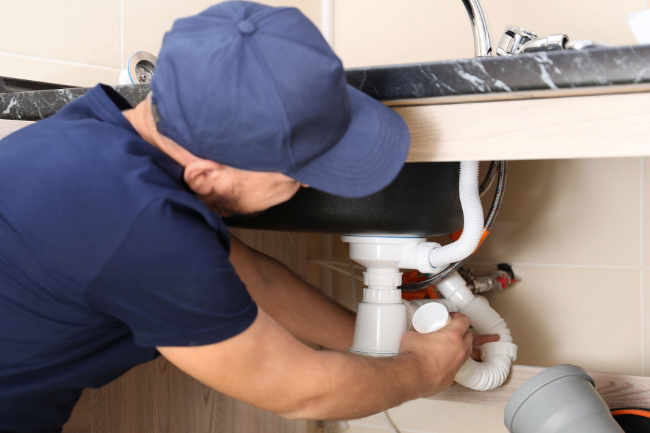
![Repiping Your Sacramento Home [6 Steps]](https://www.expresssewer.com/hs-fs/hubfs/plumbing%20tools%20and%20blueprints.jpeg?width=550)
